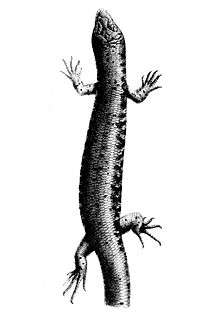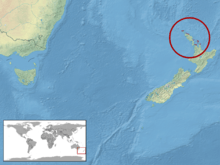Suter's skink
| Suter's skink | |
|---|---|
 | |
| Scientific classification | |
| Kingdom: | Animalia |
| Phylum: | Chordata |
| Class: | Reptilia |
| Order: | Squamata |
| Family: | Scincidae |
| Genus: | Oligosoma |
| Species: | O. suteri |
| Binomial name | |
| Oligosoma suteri (Boulenger, 1906) | |
 | |
| Synonyms[1] | |
| |
Suter's skink or the black shore skink (Oligosoma suteri) is a species of lizard in the family Scincidae. The species is endemic to New Zealand.
Oviparity
Oligosoma suteri is the only native New Zealand skink to lay eggs – hence another of its common names, the egg-laying skink. (The egg-laying rainbow skink, Lampropholis delicata, is present in some parts of New Zealand, but is introduced from Australia).[1] Females dig nests and lay eggs under sand, pebbles or boulders from late December to mid February. [2] Eggs hatch sooner if incubated at warmer temperatures, taking 75–80 days when incubated at 22°C, and approximately 55 days at a constant 26°C.[3]
Geographic range
O. suteri lives on northern offshore islands, from the Three Kings Islands to the Alderman Islands, at latitudes north of 37°S.[1][3]
Biology
Suter's skink inhabits the coast, often very close to the water, eating mainly intertidal amphipods that in turn subsist on dead seaweed. It is known to hunt for prey in rock pools and is a capable swimmer.[2] Suter's skink reaches densities (up to 13/m2) that are among the highest lizard densities recorded anywhere in the world.[4]
Etymology
Both the specific name, suteri, and one of the common names, Suter's skink, honour Henry Suter (1841–1918), New Zealand zoologist and palaeontologist.[5]
References
- 1 2 3 "Oligosoma suteri ". The Reptile Database. www.reptile-database.org.
- 1 2 Towns DR (1975). "Ecology of the black shore skink, Leiolopisma suteri (Lacertilia: Scincidae), in boulder beach habitats". New Zealand Journal of Zoology 2(4): 389–407.
- 1 2 Stenhouse, Vaughn; Carter, Anna L.; Chapple, David G.; Hare, Kelly M.; Hartley, Stephen; Nelson, Nicola J. (2018). "Modelled incubation conditions indicate wider potential distributions based on thermal requirements for an oviparous lizard". Journal of Biogeography. doi:10.1111/jbi.13363. ISSN 0305-0270.
- ↑ Polis GA, Sánchez-Piñero F, Stapp PT, Anderson WB, Rose MD (2004). "Trophic flows from water to land: marine input affects food webs of islands and coastal ecosystems worldwide." pp. 200-216. In: Polis GA, Power ME, Huxel GR (editors) (2004). Food Webs at the Landscape Level. Chicago: University of Chicago Press.
- ↑ Beolens, Bo; Watkins, Michael; Grayson, Michael (2011). The Eponym Dictionary of Reptiles. Baltimore: Johns Hopkins University Press. xiii + 296 pp. ISBN 978-1-4214-0135-5. ("Suter", p. 258).
Further reading
- Boulenger GA (1906). "Descriptions of Two New Lizards from New Zealand". Ann. Mag. Nat. Hist., Seventh Series 17: 369-371 + Plate X. (Lygosoma suteri, new species, pp. 369–370 + Plate X, figure 1).
- Hare, Kelly M.; Daugherty, Charles H.; Chapple, David G. (2008) "Comparative phylogeography of three skink species (Oligosoma moco, O. smithi, O. suteri ; Reptilia: Scincidae) in northeastern New Zealand". Molecular Phylogenetics and Evolution 46 (1): 303-315.
